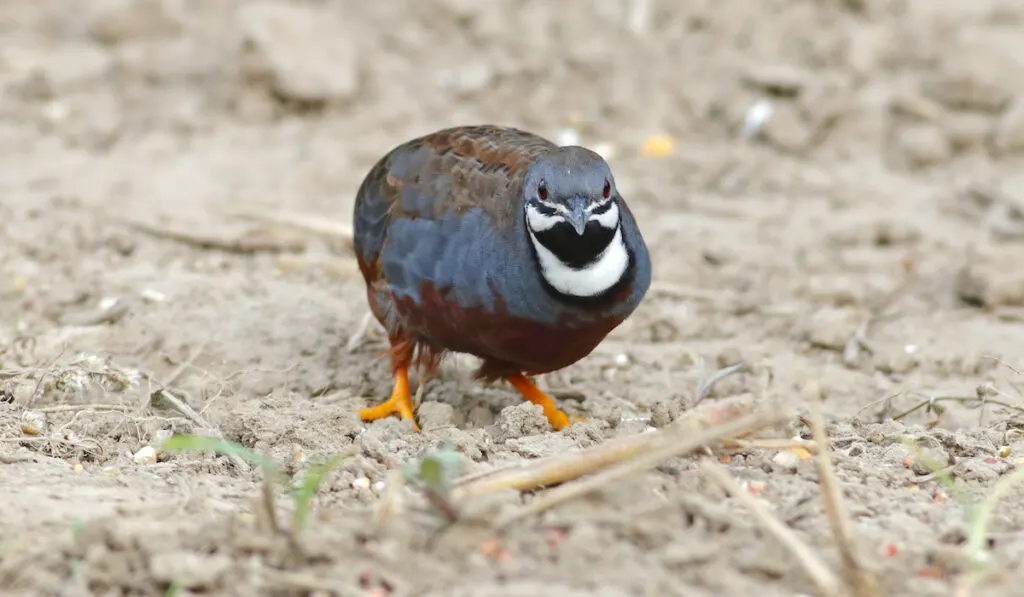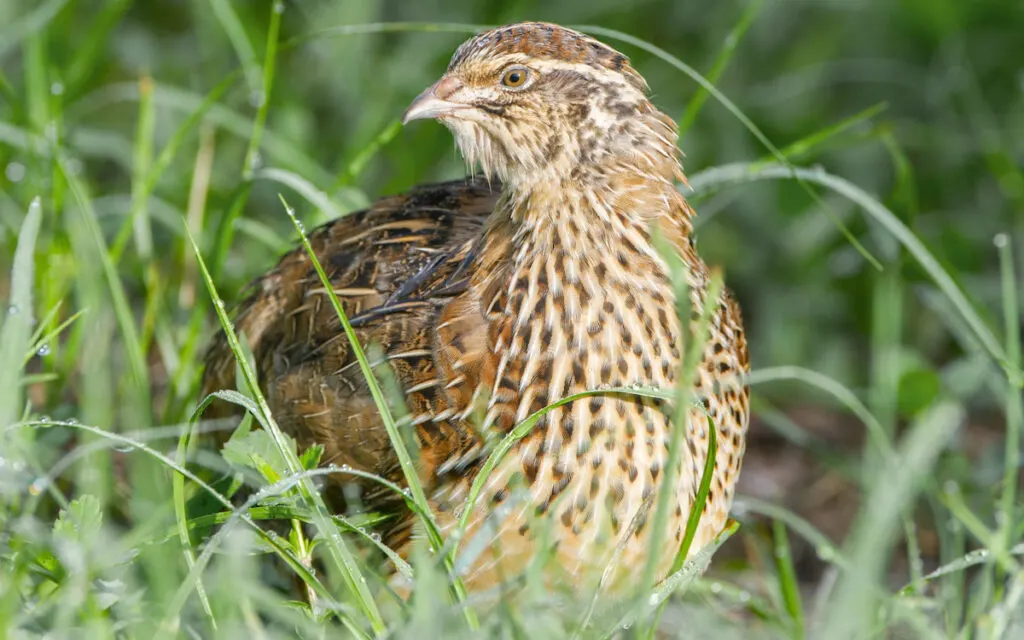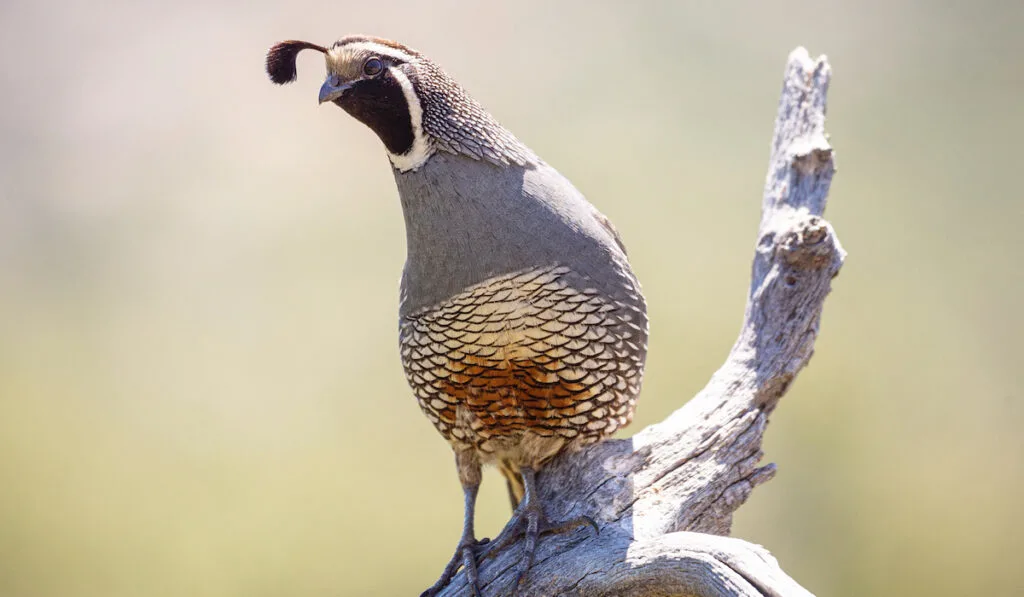On average, the over 130 quail breeds in existence lay around 200 eggs per year. But understandably, you will find those that lay well over 200 eggs in a year. You may also find those that lay at a rate below the collective average.
Quail birds are generally raised for eggs, meat, and hunting. But if you are trying to raise them mainly for their eggs, you will want to opt for the best laying breeds. To this end, we have compiled a list of some of the best quail breeds for eggs. We discuss their laying rate, their peculiarities, and much more in the rest of this article.

Table of Contents
1. Coturnix Quail
As early as 6 to 7 weeks old, Coturnix Quails start laying eggs. On average, they lay between 200 and 300 eggs per year in the right environment.
Eggs from a Coturnix Quail are typically laid just a few hours before dusk. On average, the eggs weigh around 8 to 13 grams, and as the hens become older, their eggs typically become larger.
Besides raising them for their high laying rate, you may also keep Coturnix Quails for their meat.
Compared to many other quail birds, Coturnix offer a lot of meat. So, they can be a valuable addition to your poultry.
Beyond having high production rates, Coturnix Quails are generally calm. So, they are pretty easy to raise, even for a beginner.
Their feed consumption is relatively small, and they do not necessarily need a large living area to thrive. As long as you provide clean water, proper ventilation, and a high-protein game feed, they will do well.
Coturnix Quail, also called Japanese Quail or Pharoah Quail, falls under the Old World Quail class. In the past, it was classified as a subspecies of the Common Quail. But in 1983, it became recognized as a species on its own.
The Coturnix Quail is primarily found in East Asia, where it was first domesticated. It comes in various varieties, including the following:
- Rosetta
- Italian
- Red range
- Tuxedo
- Scarlett
- English White
- Manchurian
- Tibetan
- Golden Coturnix
- Jumbo Coturnix
Of these varieties above, Jumbo Coturnix is one of the calmest and most productive.
2. Button Quail

Button Quails are estimated to lay an egg almost every day. On average, you can get about 5 eggs from them in a week. So, in a year, you can expect over 200 eggs.
Button Quails are the smallest breed of quail birds, and unsurprisingly, their eggs are small too. In fact, their chicks are almost as tiny as bumblebees upon hatching.
When button quails are not being raised for their eggs, they may also be kept as pets. However, because of their small size, they are rarely – if ever – bred for meat.
Originally, Button Quails come from India and Southeast Asia. However, they have become increasingly popular all over the world.
While they are small, Button Quails are pretty hardy. However, they do not live very long. On average, Button Quails live for 18 months. But some have lived for up to 3 years.
Button Quails are a joy to raise. Hence, their use as pets. They are quiet, active, and neat. So, raising them is pretty simple.
Like many other quail breeds, Button Quails do not need a large-sized space to thrive. However, their living area must be well-ventilated and safe from predators. The living space should also be shaded or come with some kind of privacy.
Avoid providing water for your Button Quail chicks with a waterer for chicken chicks. Remember that they are extremely small. Therefore, if they fall into the water, they may get soaked or drown.
3. Bobwhite Quail

While Bobwhite Quails are decent layers, they do not lay quite as many eggs as Coturnix Quails. On average, a Bobwhite will produce around 150 to 200 eggs per year.
The Bobwhite Quail or Northern Bobwhite originated from North America. It is found in tree edges, open forests, roads, agricultural fields, and other similar areas.
Bobwhite Quails come in up to 22 subspecies. The hens of each one of these subspecies are physically similar. However, the males are physically distinct across the subspecies.
Unlike Coturnix Quails, Bobwhite Quails do not mature until around 6 months. But like Coturnix Quails, they can lay eggs throughout the year given that conditions are optimal.
Bobwhite Quails live longer than Button Quails. They typically live as long as 5 years, and more times than not, their death stems from predation.
Generally, Bobwhite Quails are aggressive when breeding. So, if you are also raising them to reproduce, ensure you keep an optimal male to female ratio. The general recommendation is to keep 2-3 male Bobwhites per 10 females.
Bobwhite Quails are not as straightforward to raise as Coturnix Quails. One reason for this is that they have not been fully domesticated. So, if you are a beginner, you may want to consider the Coturnix breed instead.
4. European Quail

Non-broody strains of the European Quail breed can lay over 200 eggs in a year. Their eggs are creamy-white with brown patches, and they start laying at 7 weeks – almost as early as Coturnix Quails.
The European Quail also goes by the name Common Quail. It is a migratory bird, which can be found on various continents, including Africa, Europe, Asia, and the Mediterranean coast. When in the wild, European Quails live on farmlands and grasslands.
As said earlier, the Coturnix Quail breed was thought to be a subspecies of the European Quail. But now, it is a separate species on its own. So, currently, there are only 5 subspecies of the European Quail breed.
One thing you will notice is that each one of the 5 subspecies has peculiar breeding areas. However, European Quails generally breed in the Palearctic region and spend winter in southern India and Africa.
Apart from having 5 subspecies, European Quails come in 5 colors. However, following crossbreeding, these 5 colors combine to produce various other color patterns.
European Quails are one of the smallest members of the pheasant family. They look a lot like Stubble Quails.
Raising European Quails should be pretty simple for a beginner or an intermediate breeder. The general temperament of European Quails is basically like that of most other poultry birds. So, they will not act in a way that is new to you. Furthermore, they may be kept with various types of birds.
5. California Quail

Non-broody strains of the California Quail can lay as many as 200 eggs in a year. Their eggs are creamy or white with brown markings, and they weigh around 8 to 13 grams each.
California Quail originated from the United States, and as the name hints, it is the state bird of California. Understandably, the primary breeding areas of California Quails are in the western USA – where California is.
California Quails are very attractive, and they look a bit like Gambel Quails. However, Gambels live in ranges closer to the southern regions, they look scalier, and they have brighter heads.
The physical appearance of California Quails contributes to their primary use as ornamental birds. Nonetheless, if you provide the right conditions, they can lay eggs for you year-round.
Members of the California Quail breed spend most of their time on the ground; they rarely ever fly. California Quails are highly social; they enjoy being in the company of birds like them. So, if you intend to raise one, ensure you get it another California Quail or bird, so it will not be alone.
Resources
- https://backyardpoultry.iamcountryside.com/poultry-101/coturnix-quail-farming-tips
- https://backyardpoultry.iamcountryside.com/poultry-101/5-quail-species-to-raise/
- https://cs-tf.com/quail-breeds/
- https://www.roysfarm.com/japanese-quail/
- https://www.purelypoultry.com/button-quail-eggs-p-1174.html
- https://www.backyardchickens.com/threads/how-often-do-button-quail-lay-eggs.199294/
- https://www.cuteness.com/article/do-quail-lay-eggs
- http://birdcare.com.au/european_quail.htm
- https://www.worldbirdnames.org/bow/pheasants/
- http://birdcare.com.au/californian_quail.htm’
- https://www.roysfarm.com/california-quail/
